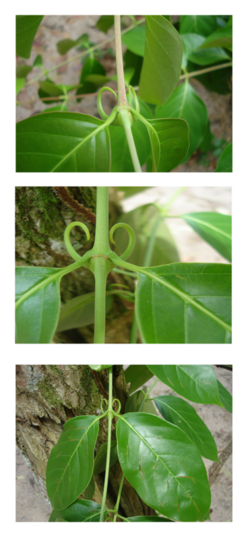Biology:Uncaria tomentosa
| Uncaria tomentosa | |
|---|---|

| |
| Scientific classification | |
| Kingdom: | Plantae |
| Clade: | Tracheophytes |
| Clade: | Angiosperms |
| Clade: | Eudicots |
| Clade: | Asterids |
| Order: | Gentianales |
| Family: | Rubiaceae |
| Genus: | Uncaria |
| Species: | U. tomentosa
|
| Binomial name | |
| Uncaria tomentosa (Willd. ex Schult.) DC.[1]
| |
Uncaria tomentosa is a woody vine found in the tropical jungles of South and Central America. It is known as cat's claw or uña de gato in Spanish because of its claw-shaped thorns.[1][2] The plant root bark is used in herbalism for a variety of ailments, and is sold as a dietary supplement.[2][3][4]
Evidence anti-inflammatory action is limited to cell culture studies.[5][6] and has not been demonstrated in randomized control human trials.[citation needed] Cat's claw is being studied for a number of other possible uses, including HIV, Crohn disease, multiple sclerosis, systemic lupus erythematosus (SLE or lupus), endometriosis, kidney problems, bladder cancer, and Alzheimer disease. More research is needed before scientists can say whether it is effective.[7][8]
Description
Uncaria tomentosa is a liana deriving its name from hook-like thorns that resemble the claws of a cat.[2] U. tomentosa can grow to a length of up to 30 m (100 ft), climbing by means of these thorns.[1] The leaves are elliptic with a smooth edge, and grow in opposing pairs. Cat's claw is indigenous to the Amazon rainforest, with its habitat being restricted primarily to the tropical areas of South and Central America.[1]
Taxonomy
There are two species of cat's claw commonly used in North America and Europe, Uncaria tomentosa and Uncaria guianensis, having different properties and uses.[2] The two are frequently confused but U. tomentosa is the more commonly used in traditional medicine.[9][10] U. tomentosa is further divided into two chemotypes that remain under preliminary research for their properties and compounds.[11] There are other plants which are known as cat's claw (or uña de gato) in Mexico and Latin America; however, they are entirely different plant species, belonging to neither the genus Uncaria, nor to the family Rubiaceae.[10]
Phytochemicals
Phytochemicals in Uncaria tomentosa root bark include oxindole and indole alkaloids, glycosides, organic acids, proanthocyanidins, sterols, and triterpenes, glycosides, tannins, polyphenols, catechins, rhynchophylline, and beta-sitosterol.[2][10][12]
Traditional medicine
Cat's claw bark has been used as a traditional medicine in South American countries over centuries for its supposed health benefits, and is a common herbal supplement.[2][4][10] As of 2021, there is no high-quality clinical evidence that it has any benefit in treating human diseases.[2][4]
Interactions
Cat's claw has extensive interactions with numerous prescription drugs.[2] Its safety over long-term use or during pregnancy has not been scientifically determined.[2][4]
Adverse effects
Individuals allergic to plants in the family Rubiaceae and different species of Uncaria may be more likely to have adverse reactions to cat's claw.[2] Allergic reactions can include itching, rash, and skin inflammation.[2] Gastrointestinal discomfort, nausea, headache, impaired kidney and hormonal effects, and neuropathy are other possible effects.[2][4]
People requiring anticoagulation, blood pressure, or immune therapy should not use cat's claw.[2][4]
See also
- List of ineffective cancer treatments
References
- ↑ 1.0 1.1 1.2 1.3 {{citation | mode = cs1 | title = Uncaria tomentosa | work = Germplasm Resources Information Network (GRIN) | url = | publisher = [[Organization:Agricultural Research ServAgricultural Research Service (ARS), United States Department of Agriculture (USDA) | access-date = 2008-03-01 }}
- ↑ 2.00 2.01 2.02 2.03 2.04 2.05 2.06 2.07 2.08 2.09 2.10 2.11 2.12 "Cat's claw". Drugs.com. 6 September 2021. https://www.drugs.com/npp/cat-s-claw.html.
- ↑ "Assessment report on Uncaria tomentosa (Willd. ex Schult.) DC., cortex". European Medicines Agency. 10 March 2015. https://www.ema.europa.eu/documents/herbal-report/draft-assessment-report-uncaria-tomentosa-willd-ex-schult-dc-cortex_en.pdf.
- ↑ 4.0 4.1 4.2 4.3 4.4 4.5 "Cat's claw". National Center for Complementary and Integrative Health, US National Institutes of Health. 1 May 2020. https://www.nccih.nih.gov/health/cats-claw.
- ↑ Sandoval-Chacón, M; Thompson, JH; Zhang, XJ; Liu, X; Mannick, EE; Sadowska-Krowicka, H; Charbonnet, RM; Clark, DA et al. (December 1998). "Antiinflammatory actions of cat's claw: the role of NF-κB". Alimentary Pharmacology & Therapeutics 12 (12): 1279–1289. doi:10.1046/j.1365-2036.1998.00424.x. PMID 9882039.
- ↑ Miller, Mark J. S.; Zhang, Xiao-Jing; Charbonnet, Randi M.; Clark, David A.; Sandoval, Manuel (April 1999). "The Anti-Inflammatory Actions of the Herbal Medicine, Cat's Claw, Are Due to a Suppression of NF-κB Activation and Inhibition of Gene Expression". Pediatric Research 45 (7): 114. doi:10.1203/00006450-199904020-00676.
- ↑ "Cat's claw Information". Mount Sinai Health System. https://www.mountsinai.org/health-library/herb/cats-claw.
- ↑ Patel, Kamal. "Research Breakdown on Cat's claw". Examine. https://examine.com/supplements/cats-claw/research/.
- ↑ "Morphoanatomical Studies of Uncaria tomentosa and Uncaria guianensis Bark and Leaves". Phytomedicine 11 (2–3): 213–223. 2004. doi:10.1078/0944-7113-00315. PMID 15070175.
- ↑ 10.0 10.1 10.2 10.3 "Detailed Scientific Review of Cat's Claw (archived)". M.D. Anderson Center. 31 May 2006. http://www.mdanderson.org/education-and-research/resources-for-professionals/clinical-tools-and-resources/cimer/therapies/herbal-plant-biologic-therapies/cats-claw-scientific.html.
- ↑ "Uncaria tomentosa (Willd.) DC. — Ethnomedicinal Use and New Pharmacological, Toxicological and Botanical Results". Journal of Ethnopharmacology 64 (1): 23–34. 1999. doi:10.1016/S0378-8741(98)00096-8. PMID 10075119. http://www.samento.com.ec/sciencelib/sarticles/Uncaria81B4.pdf.
- ↑ Cat's claw. LiverTox, US National Institute of Diabetes and Digestive and Kidney Diseases. 18 February 2019. https://www.ncbi.nlm.nih.gov/books/NBK548323/.
External links
- Santa Maria, A; Lopez, A; Diaz, M.M; Albán, J; Galán de Mera, A; Vicente Orellana, J.A; Pozuelo, J.M (August 1997). "Evaluation of the toxicity of Uncaria tomentosa by bioassays in vitro". Journal of Ethnopharmacology 57 (3): 183–187. doi:10.1016/S0378-8741(97)00067-6. PMID 9292411.
- Yunis Aguinaga, Jefferson; Claudiano, Gustavo S.; Marcusso, Paulo F.; Ikefuti, Cynthia; Ortega, George G.; Eto, Silas F.; da Cruz, Claudinei; Moraes, Juliet R. E. et al. (2014). "Acute Toxicity and Determination of the Active Constituents of Aqueous Extract of Uncaria tomentosa Bark in Hyphessobrycon eques". Journal of Toxicology 2014: 412437. doi:10.1155/2014/412437. PMID 24734041.
- Uncaria tomentosa List of Chemicals (Dr. Duke's Databases)
Wikidata ☰ Q1123391 entry
 |

